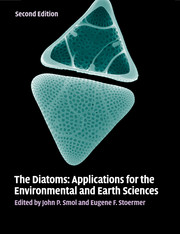Book contents
- Frontmatter
- Contents
- List of contributors
- Preface
- Part I Introduction
- Part II Diatoms as indicators of environmental change in flowing waters and lakes
- Part III Diatoms as indicators in Arctic, Antarctic, and alpine lacustrine environments
- Part IV Diatoms as indicators in marine and estuarine environments
- 15 Diatoms and environmental change in large brackish-water ecosystems
- 16 Applied diatom studies in estuaries and shallow coastal environments
- 17 Estuarine paleoenvironmental reconstructions using diatoms
- 18 Diatoms on coral reefs and in tropical marine lakes
- 19 Diatoms as indicators of former sea levels, earthquakes, tsunamis, and hurricanes
- 20 Marine diatoms as indicators of modern changes in oceanographic conditions
- 21 Holocene marine diatom records of environmental change
- 22 Diatoms as indicators of paleoceanographic events
- 23 Reconsidering the meaning of biogenic silica accumulation rates in the glacial Southern Ocean
- Part V Other applications
- Part VI Conclusions
- Glossary, acronyms, and abbreviations
- Index
- References
16 - Applied diatom studies in estuaries and shallow coastal environments
from Part IV - Diatoms as indicators in marine and estuarine environments
Published online by Cambridge University Press: 05 June 2012
- Frontmatter
- Contents
- List of contributors
- Preface
- Part I Introduction
- Part II Diatoms as indicators of environmental change in flowing waters and lakes
- Part III Diatoms as indicators in Arctic, Antarctic, and alpine lacustrine environments
- Part IV Diatoms as indicators in marine and estuarine environments
- 15 Diatoms and environmental change in large brackish-water ecosystems
- 16 Applied diatom studies in estuaries and shallow coastal environments
- 17 Estuarine paleoenvironmental reconstructions using diatoms
- 18 Diatoms on coral reefs and in tropical marine lakes
- 19 Diatoms as indicators of former sea levels, earthquakes, tsunamis, and hurricanes
- 20 Marine diatoms as indicators of modern changes in oceanographic conditions
- 21 Holocene marine diatom records of environmental change
- 22 Diatoms as indicators of paleoceanographic events
- 23 Reconsidering the meaning of biogenic silica accumulation rates in the glacial Southern Ocean
- Part V Other applications
- Part VI Conclusions
- Glossary, acronyms, and abbreviations
- Index
- References
Summary
Introduction
Diatoms are an important and often dominant component of benthic microalgal assemblages in estuarine and shallow coastal environments. This chapter will be concerned mainly with motile diatom assemblages on sediments in these environments and secondarily with epiphytic diatom assemblages on submerged aquatic vegetation. Admiraal (1984) provided an excellent summary of the ecology of estuarine sediment-inhabiting diatoms and Underwood and Kromkamp (1999) an excellent review of microphytobenthos primary production in estuaries.
Many topics were covered in the above two works, including the distribution, effects of physicochemical factors, population growth, primary production, and interactions with herbivores in Admiraal's work, and a summary of the main factors affecting production and biomass of microphytobenthos (diatom-dominated) within microtidal temperate estuaries in Underwood and Kromkamp's review. The focus of the present review will be considerably narrower because only those applied studies that have focused on the autecology of particular diatom species or that have utilized structural (e.g. species diversity) and/or functional (e.g. primary production rates) attributes of benthic diatom assemblages will be considered. By “applied” we mean studies that treat benthic diatom assemblages as tools to address concerns about larger ecosystem problems such as cultural eutrophication of estuarine and shallow coastal environments. The three diatom-related research topics that will be reviewed in this chapter include eutrophication and sediment toxicity, sediment stability, and contribution of benthic diatom assemblages to global primary production and their role in food webs.
- Type
- Chapter
- Information
- The DiatomsApplications for the Environmental and Earth Sciences, pp. 309 - 323Publisher: Cambridge University PressPrint publication year: 2010
References
- 11
- Cited by



